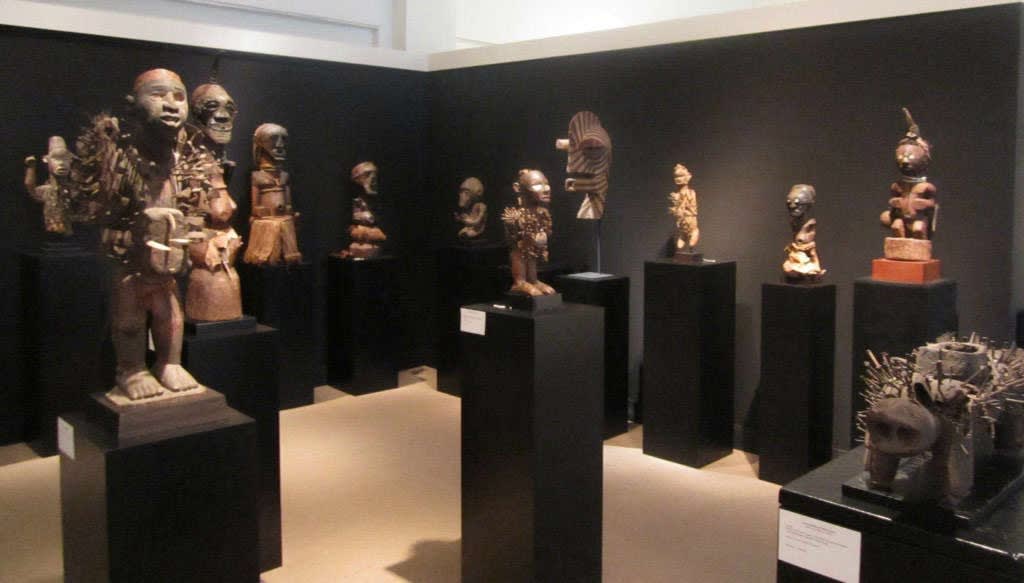
With a total result of $ 5 million (including buyer’s premium), the second part of Sotheby’s sale of the Allan Stone collection failed to outperform the first part – which did more than twice as good at $ 11,5 million. The statistics don’t give a very positive image: of the 91 African art lots, 38 (or 42 %) sold below the low estimate – a sharp contrast with the first part last November, were 65 % of the sale sold above the high estimate. Additionally, 14 objects failed to sell. 14 objects sold within their estimate and 25 (or 27,5 %) above their high estimate. By lot, 85 % was sold (not much less than the 94 % in the first part), but in almost half the cases below the estimate; and with 10 lots at half the low estimate. Luckily for Sotheby’s, the reserves apparently were rather low. Next to the fact that the estimates might have been too steep, there wasn’t much action in the sale room either. In comparision with the first part, not that many European dealers were present. Due to the lack of exuberant record prices, I had the feeling not as many collectors from other art segments were bidding either. I guess the African art market just got a little bit smaller again. Besides, there’s a limit in what this small niche market can absorb within a certain period of time.
The total low and high estimate of the sale were (roughly) $ 5,6 million and $ 8,5 million. With a total result (without premium) of a little less than $ 4 million it is clear this sale was not good. The main reason appears to be the fact that almost all top lots didn’t sell as good as was expected, or not at all. Important lots that failed to sell were the Kongo-Yombe figure (lot 47), estimated at $ 700K-1,000K it was passed at $ 420K and a Songye figure (lot 70) (estimated $ 600,000-900,000) which failed to find a buyer at $ 460,000. Other top lots didn’t do very well either; the back cover lot, the Kongo figure from a known hand sold below its low estimate at $ 440K (without premium) – Sotheby’s clearly had much higher hopes for this one, but the three pages didn’t help. The Kongo-Vili janus dog figure (lot 55), estimated $ 150K-250K, sold for $ 95K (excl. premium) . Another Kongo figure (lot 57) sold for $ 300K (without premium), $ 100K below its low estimate. Another three-page lot that didn’t perform as expected, the Songye figure from the cover (lot 67), estimated at $ 1,000,000-1,500,000, sold for $ 800,000. No objects in the sale succeeded in selling above the one million dollar mark. The aforementioned Songye came closest, with the premium included, at $ 965,000. The only Songye figure that did ‘well’ was lot 77, which sold in the middle of its estimate at $ 400K (without premium).
A lot of objects sold at their starting bid (often half the low estimate) with only one interested party: lot 19, lot 26, lot 27, lot 34, lot 35, lot 37, lot 56, lot 64. Some of these were real bargains, for example an Ejagham panel (lot 25) sold for $ 15K (half its lowest estimate) and a magnificent Urhobo figure at $ 30K (again half the estimate).
There weren’t that many surprises in the sale: a big Senufo horse (lot 12), estimated $ 4K-6K, sold for $ 30K – after all a rare type of object; a nice Asante stool sold for $ 11K (with an estimate of $ 3K-5K); a seated Kongo-Yombe figure (lot 59) sold for $ 55K (estimated $ 6K-9K) and an “Eastern Congolese” figure (lot 66), estimated $ 15K-25K, sold for $ 60K – clearly some people knew more about this mysterious figure.
Lastly, two personal favourites did very well: the rare Bidjogo ‘figure’ which sold for $ 90K to a New York dealer and the expressionistic Makonde mask, which sold for $ 9,000 – a steal.